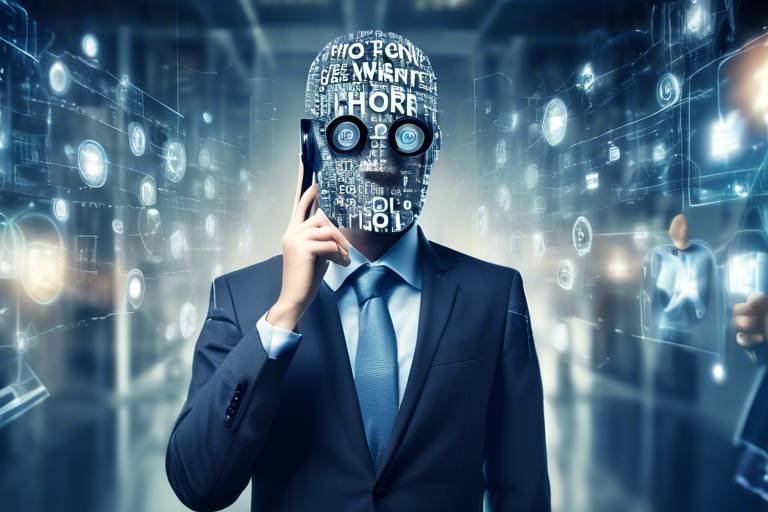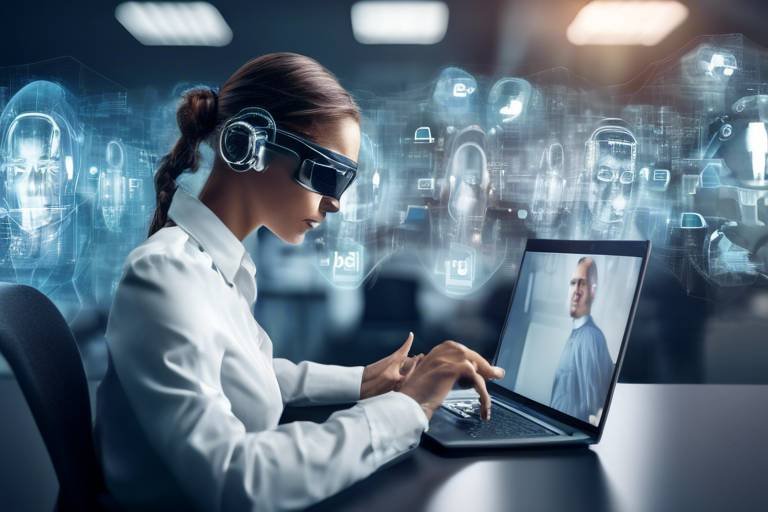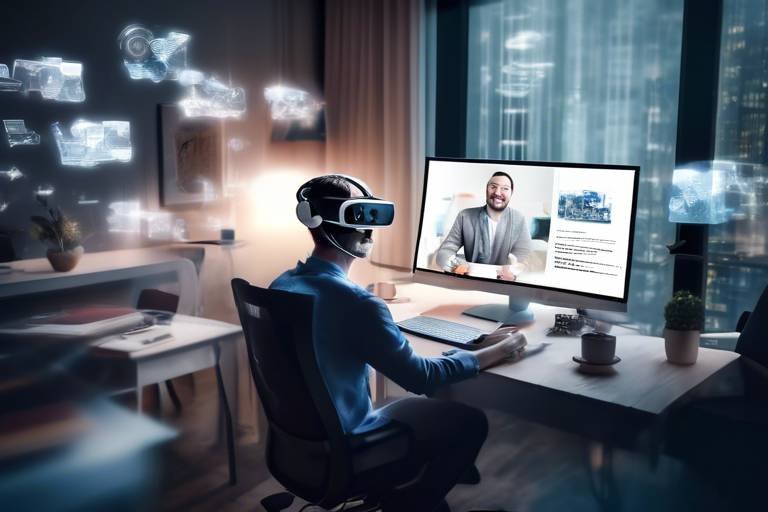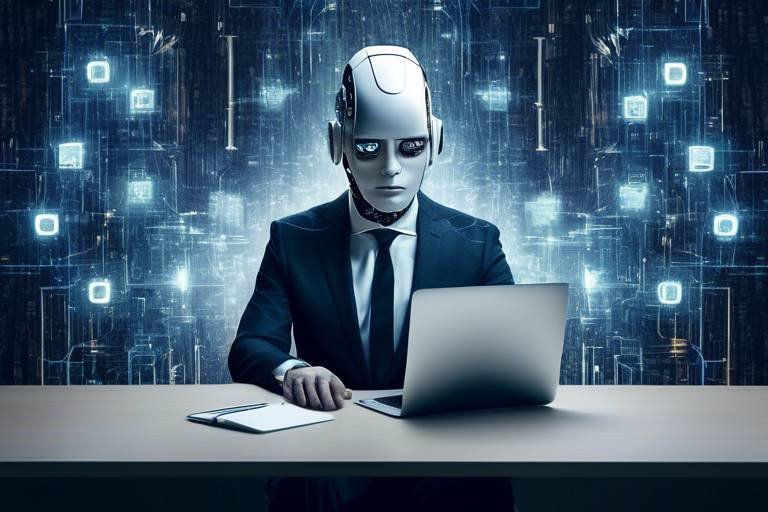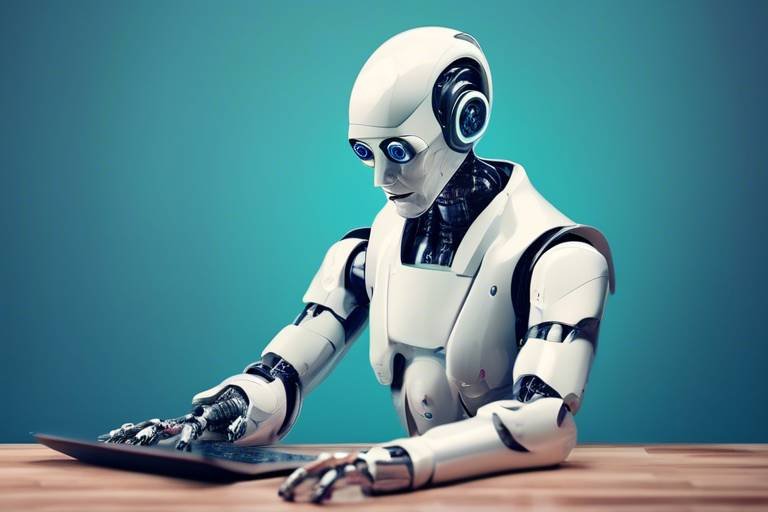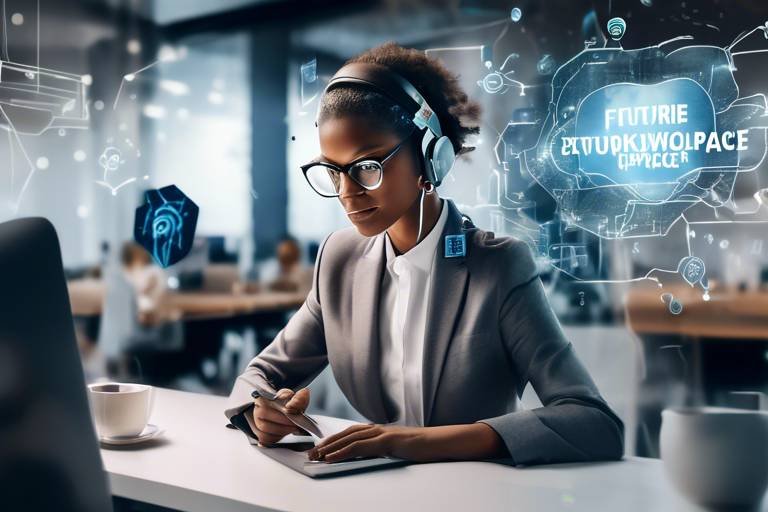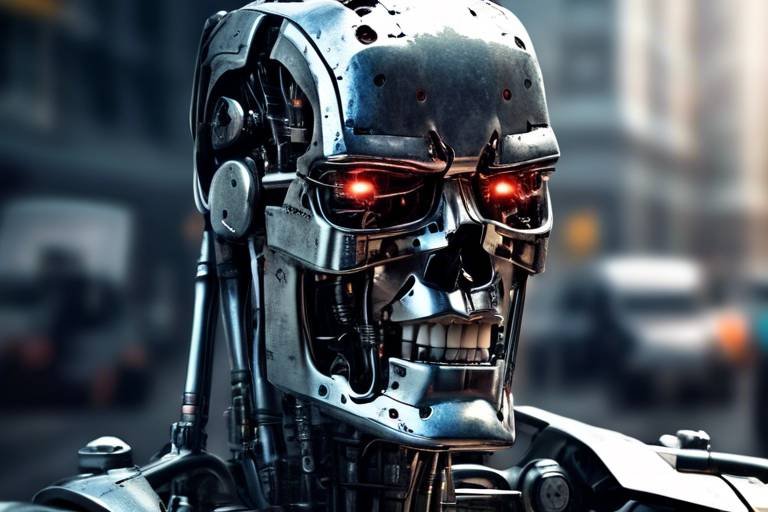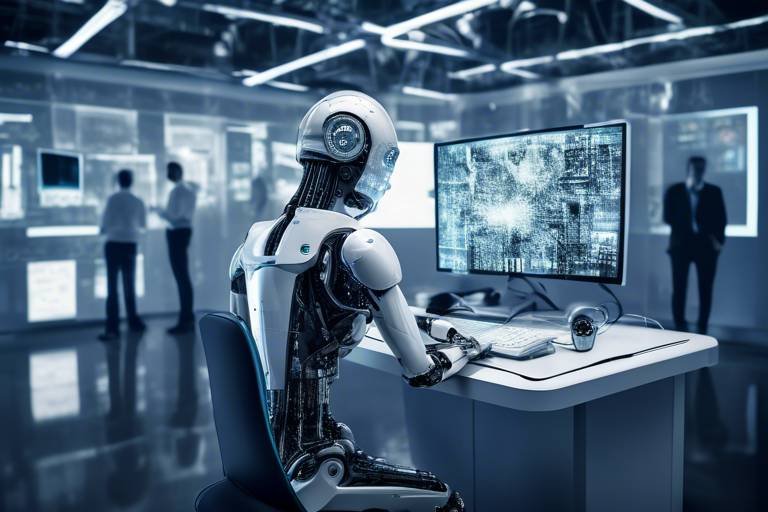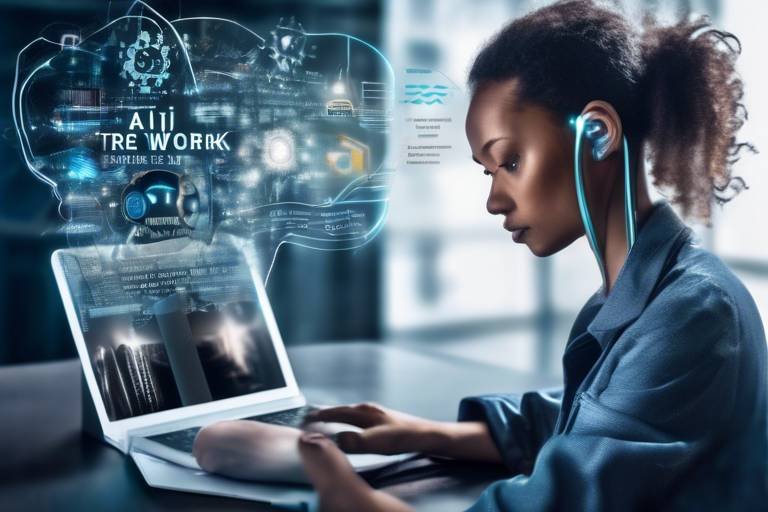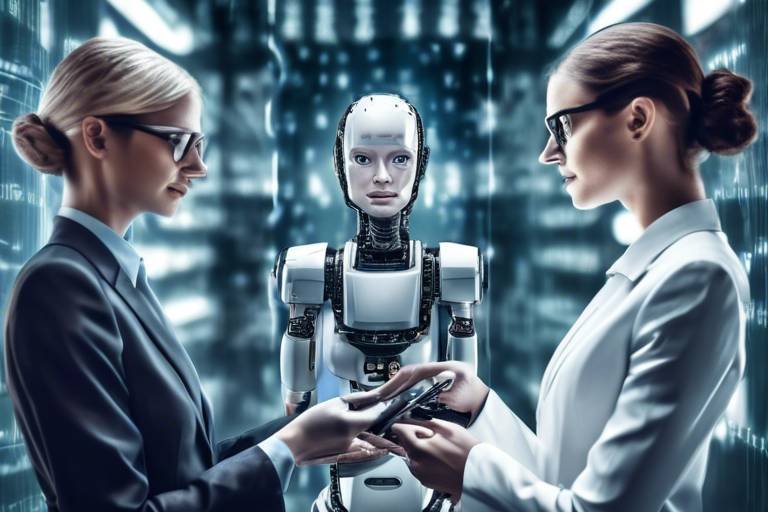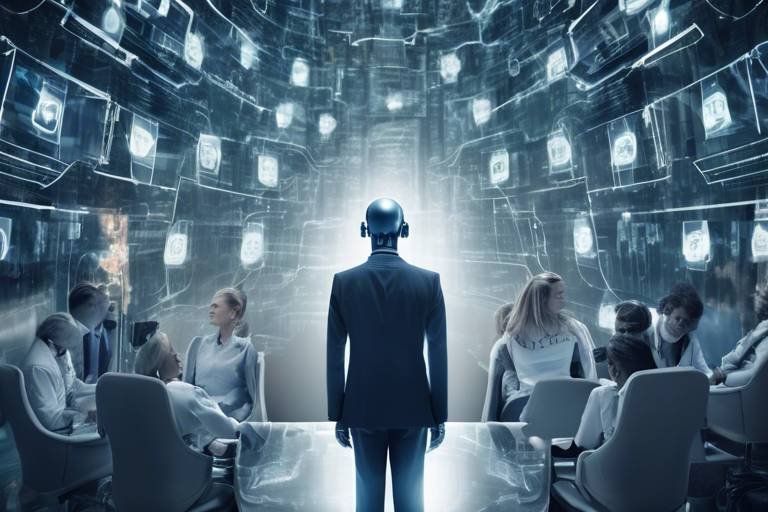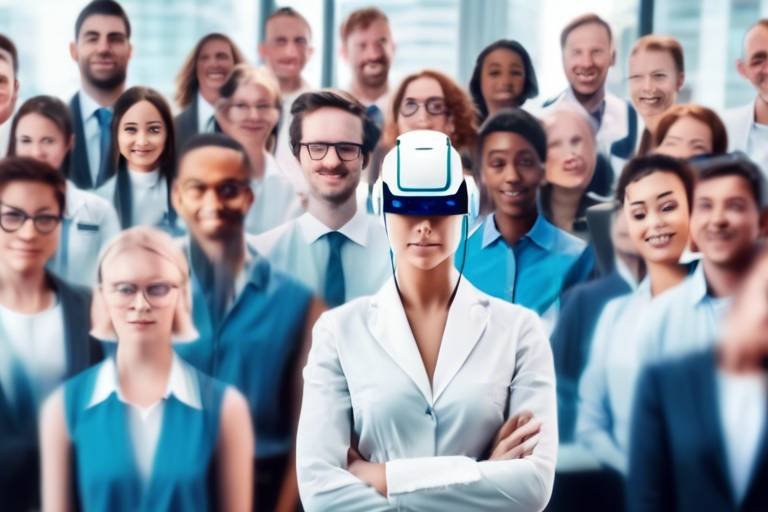The Development of AI and its Effect on Professions
In recent years, the world has witnessed a remarkable transformation driven by the rise of artificial intelligence (AI). This technology isn't just a buzzword; it's reshaping various professions and industries, creating a blend of opportunities and challenges that professionals must navigate. Imagine a world where machines can analyze data faster than a human can blink or where algorithms can predict consumer behavior with uncanny accuracy. This is not science fiction; this is the reality we are living in today. As we delve into the intricacies of AI's impact on the workforce, we will explore not only the advancements in AI technologies but also how these changes are influencing employment dynamics and the nature of work itself.
Artificial intelligence has made leaps and bounds in recent years, particularly in areas like machine learning and natural language processing. These technologies are not just reshaping industries; they are creating entirely new paradigms of operation. For instance, machine learning enables computers to learn from data patterns, improving their performance without explicit programming. Natural language processing, on the other hand, allows machines to understand and interact in human languages, making communication between humans and machines more seamless than ever before.
These advancements are not limited to tech companies. Industries such as healthcare, finance, and even agriculture are leveraging AI to enhance efficiency and effectiveness. For example, in healthcare, AI algorithms can analyze medical images faster and with greater accuracy than human radiologists, leading to quicker diagnoses and better patient outcomes. In finance, AI-driven systems are capable of detecting fraudulent activities in real-time, safeguarding consumers and institutions alike. The possibilities are endless, and as AI continues to evolve, so too will its applications across various sectors.
As AI technologies advance, they inevitably influence job availability and the nature of work. While some fear that AI will lead to significant job displacement, it's essential to recognize that it also creates new roles that didn't exist before. The workforce is in a state of flux, and understanding this dynamic is crucial. For instance, while AI can automate certain tasks, it also requires skilled individuals to manage and maintain these systems. This duality presents both challenges and opportunities for workers across the globe.
One of the most notable impacts of AI is the automation of routine tasks. By taking over repetitive and mundane activities, AI allows professionals to focus on more complex responsibilities that require critical thinking and creativity. This shift can lead to increased job satisfaction, as employees spend less time on tedious tasks and more time on work that truly engages their skills and talents.
AI's ability to automate routine tasks is revolutionizing the workplace. Imagine a world where data entry, scheduling, and even customer inquiries are handled by intelligent systems. This not only increases efficiency but also reduces the likelihood of human error. Professionals can now dedicate their time to strategic planning, problem-solving, and innovative thinking, which are essential for organizational growth. In essence, AI is not just a tool; it's a partner that enhances human capabilities.
Several industries have already experienced the transformative power of AI-driven automation. Consider the manufacturing sector, where robots equipped with AI can perform assembly line tasks with precision and speed. This has led to a significant increase in productivity, allowing companies to produce more while minimizing costs. Similarly, in customer service, AI chatbots can handle thousands of inquiries simultaneously, providing instant responses and freeing human agents to handle more complex issues. These case studies exemplify how automation is not merely a replacement for human labor but a catalyst for improved productivity and efficiency.
Despite the numerous advantages of automation, it is not without its challenges. One of the most pressing issues is the need for workforce retraining. As certain roles become obsolete, there is a growing demand for new skills that align with the evolving job market. This transition can be daunting for many workers, particularly those who have been in the same profession for years. Additionally, there is a risk of increased inequality, as those with access to education and training may thrive, while others may struggle to adapt. Addressing these challenges is crucial to ensuring that the benefits of AI are shared equitably across society.
As AI continues to evolve, it is also giving rise to entirely new job categories. Roles such as AI ethicists, data scientists, and machine learning engineers are becoming increasingly vital in today’s workforce. These positions require a different skill set and knowledge base, emphasizing the importance of continuous learning and adaptability in the modern job market. The emergence of these new professions signals a shift in employment trends, highlighting the need for educational institutions and training programs to align with the demands of an AI-driven economy.
AI's influence extends beyond technical fields; it is also making waves in creative professions like art, music, and writing. The intersection of technology and creativity raises intriguing questions about originality and authorship. Can a piece of art generated by an algorithm be considered genuine? As AI tools become more advanced, they are increasingly used by artists and writers to enhance their work rather than replace it. This collaboration between humans and machines opens up new avenues for creativity, allowing professionals to push the boundaries of their craft.
Many creatives are discovering that AI can serve as a powerful ally in their work. For instance, musicians are using AI to generate unique sounds and compositions, while writers are leveraging AI tools to brainstorm ideas and refine their prose. This partnership allows artists to explore uncharted territories and experiment with new styles, ultimately enriching their creative process. Rather than viewing AI as a competitor, many professionals are embracing it as a collaborator, enhancing their artistry in ways previously unimaginable.
With the rise of AI in creative fields comes a host of ethical considerations. Issues such as copyright and the definition of authorship are becoming increasingly complex. If an AI generates a piece of art or literature, who owns the rights to that work? Furthermore, as AI systems learn from existing creative works, there are concerns about originality and the potential for plagiarism. Navigating these ethical dilemmas will be essential as we continue to integrate AI into the creative landscape.
- Will AI replace all jobs? While AI may automate certain tasks, it is more likely to change the nature of work and create new job opportunities.
- What skills will be in demand in an AI-driven job market? Skills related to data analysis, machine learning, and creativity will be highly sought after.
- How can workers prepare for the changes brought by AI? Continuous learning and adaptability are key. Upskilling and reskilling will help workers stay relevant.
- What are the ethical implications of AI in creative fields? Issues surrounding copyright, authorship, and originality are important considerations as AI becomes more integrated into creative processes.

The Rise of AI Technologies
The world is witnessing a remarkable transformation thanks to the rise of artificial intelligence (AI) technologies. From the way we interact with our devices to how businesses operate, AI is reshaping the landscape of various industries. At the heart of this revolution are advancements in machine learning and natural language processing (NLP), which have paved the way for applications that were once thought to be the stuff of science fiction. Imagine a world where machines can learn from experience, adapt to new inputs, and perform human-like tasks—this is the reality we are stepping into.
Machine learning, a subset of AI, allows systems to analyze data, identify patterns, and make decisions with minimal human intervention. This capability is not just a novelty; it has become a vital component in sectors such as healthcare, finance, and transportation. For instance, in healthcare, AI algorithms can analyze medical images with astonishing accuracy, assisting doctors in diagnosing diseases faster and more reliably. Similarly, in finance, AI-driven analytics can predict market trends, giving investors a competitive edge.
Natural language processing, on the other hand, enables machines to understand and generate human language. This technology is behind the voice assistants we rely on, such as Siri and Alexa, as well as chatbots that enhance customer service experiences. With NLP, businesses can engage with customers in a more personalized manner, fostering stronger relationships and improving satisfaction. It's fascinating to consider how these technologies are not just tools but are becoming integral to our daily lives.
As we delve deeper into the rise of AI technologies, it’s essential to recognize the global impact they have. Companies across the globe are investing heavily in AI research and development, recognizing its potential to drive efficiency and innovation. According to a recent report, global spending on AI technologies is expected to exceed $500 billion by 2024, showcasing the urgency and importance of this technological shift.
However, with great power comes great responsibility. As we embrace AI technologies, we must also consider the ethical implications and challenges that arise. Issues such as data privacy, algorithmic bias, and the potential for job displacement are critical conversations that need to happen alongside technological advancements. It’s not just about what AI can do, but also about how we can harness its capabilities responsibly.
In conclusion, the rise of AI technologies is not merely a trend; it is a revolution that is here to stay. As we navigate this new landscape, it’s crucial for professionals across all fields to adapt and evolve. The future may be uncertain, but one thing is clear: AI will continue to play a pivotal role in shaping our world.
- What is artificial intelligence? AI refers to the simulation of human intelligence in machines that are programmed to think and learn like humans.
- How is AI used in healthcare? AI is used in healthcare for diagnostics, personalized medicine, and predictive analytics to improve patient outcomes.
- What are the ethical concerns surrounding AI? Ethical concerns include data privacy, algorithmic bias, and the impact on employment.
- Will AI replace human jobs? While AI may automate certain tasks, it also creates new job opportunities and can enhance human work.

Impact on Employment
The advent of artificial intelligence (AI) is not just a technological revolution; it's a seismic shift in the way we work. As AI continues to evolve, it's reshaping the employment landscape in ways that are both exciting and daunting. Imagine a world where machines can perform tasks that once required human intuition and creativity. This transformation is leading to a dual narrative: on one hand, we see the potential for job displacement, while on the other, new roles are emerging that demand fresh skills and competencies. It's like watching a game of chess unfold, where every move can lead to unexpected outcomes.
One of the most striking impacts of AI on employment is the automation of tasks that were traditionally performed by humans. For instance, consider industries like manufacturing, where robots are increasingly taking over repetitive tasks on assembly lines. This shift not only increases efficiency but also allows human workers to focus on more complex and strategic responsibilities. It's akin to a chef delegating chopping vegetables to a food processor, freeing them to create more intricate dishes. However, this efficiency comes at a cost—many workers may find their roles becoming obsolete as machines take over their responsibilities.
To illustrate the impact of AI on various sectors, let's take a look at a few key areas:
| Industry | AI Impact | Job Changes |
|---|---|---|
| Manufacturing | Increased automation of assembly lines | Reduction in manual labor jobs, rise in robotics maintenance roles |
| Customer Service | Use of chatbots and AI-driven support | Decrease in entry-level positions, growth in tech support roles |
| Healthcare | AI for diagnostics and patient management | Less need for administrative roles, more demand for data analysts |
While the benefits of AI are clear, we cannot ignore the challenges that come with this transformation. For every job that is automated, there is a pressing need for workforce retraining. Employees must adapt to new technologies and learn how to work alongside AI systems. This is where the concept of lifelong learning becomes crucial. Just as a gardener must continuously tend to their plants to ensure growth, workers must cultivate new skills to thrive in an AI-driven economy.
Moreover, the rapid pace of automation could exacerbate existing inequalities. Those with access to education and training will likely thrive, while others may find themselves left behind. The disparity between tech-savvy individuals and those who struggle with digital literacy could widen, creating a chasm in the job market. It's essential for policymakers and educators to address these issues proactively, ensuring that everyone has the opportunity to succeed in this new landscape.
In summary, while AI presents remarkable opportunities for efficiency and innovation, it also poses significant challenges to employment. The key will be to strike a balance between embracing technological advancements and ensuring that workers are equipped to navigate the changing job market. After all, the future of work should not just be about machines; it should be about *people*—their skills, their creativity, and their ability to adapt.
- Will AI replace all jobs? While AI will automate certain tasks, it will also create new job opportunities that require human skills.
- What types of jobs are most at risk from AI? Roles that involve repetitive tasks, such as assembly line work and basic customer service, are more susceptible to automation.
- How can workers prepare for the changes brought by AI? Upskilling and reskilling through training programs and continuous education will be crucial for adapting to new job demands.
- Is there a way to prevent job loss due to AI? Policymakers can implement strategies such as retraining programs and support for displaced workers to mitigate job loss.

Automation of Routine Tasks
In today's fast-paced world, the through artificial intelligence (AI) is not just a trend; it's a revolution that is reshaping how we work. Imagine a world where mundane tasks are handled by machines, freeing up valuable time for professionals to engage in more complex and creative responsibilities. Sounds appealing, right? This shift is already happening in various industries, leading to increased efficiency and productivity.
AI technologies, such as machine learning and natural language processing, are at the forefront of this transformation. They can process vast amounts of data at lightning speed, allowing businesses to automate repetitive tasks that once consumed hours of human labor. For instance, in the realm of customer service, chatbots are now capable of handling inquiries 24/7, providing instant responses and significantly reducing the workload on human agents. This not only enhances customer satisfaction but also allows human employees to focus on more nuanced issues that require a personal touch.
Consider the implications of this automation. In a typical office environment, tasks like scheduling meetings, sorting emails, and generating reports can be time-consuming. By implementing AI-driven tools, organizations can streamline these processes. For example, AI can analyze incoming emails, categorize them based on urgency, and even draft preliminary responses. This level of efficiency allows employees to devote their time to strategic planning and creative problem-solving rather than getting bogged down in administrative tasks.
However, while the benefits are clear, there are also challenges that come with the territory. The shift towards automation raises questions about job displacement. As machines take over routine tasks, what happens to the employees who once performed these duties? It's essential for businesses to recognize that while automation can lead to job loss in some areas, it also opens the door for new roles that focus on managing and optimizing these AI systems. The key is to ensure that the workforce is equipped with the necessary skills to thrive in this evolving landscape.
To illustrate the impact of automation, let's look at a few examples across different sectors:
| Industry | Routine Task Automated | Impact |
|---|---|---|
| Manufacturing | Assembly line tasks | Increased production speed and reduced errors |
| Finance | Data entry and analysis | Faster reporting and improved accuracy |
| Retail | Inventory management | Real-time stock updates and reduced waste |
As we can see, the automation of routine tasks can lead to significant improvements in productivity and efficiency across various industries. However, it is crucial to approach this transition with a balanced perspective. While we celebrate the advantages, we must also prepare for the challenges that come with integrating AI into our daily workflows.
In conclusion, the automation of routine tasks through AI is a double-edged sword. It offers incredible opportunities for enhancing productivity and allowing professionals to focus on higher-level responsibilities, but it also necessitates a thoughtful approach to workforce management and retraining. As we continue to embrace this technological evolution, staying informed and adaptable will be key to thriving in the future job market.

Case Studies in Automation
As we dive into the world of automation, it's fascinating to see how various industries have embraced AI technologies, leading to transformative changes in job roles and productivity. Let's take a closer look at some compelling case studies that illustrate the significant impact of automation across different sectors.
One of the most notable examples comes from the manufacturing industry. Companies like Toyota have integrated advanced robotics into their assembly lines, allowing machines to handle repetitive tasks such as welding and painting. This shift not only boosts efficiency but also enhances product quality. In fact, Toyota reported a 30% increase in production efficiency after implementing automated processes, showcasing how AI can streamline operations while maintaining high standards.
In the realm of customer service, organizations have turned to AI-driven chatbots to manage inquiries and support requests. For instance, Sephora, a leader in the beauty industry, utilizes AI chatbots on their website and mobile app to assist customers with product recommendations and order tracking. This automation has allowed Sephora to handle thousands of customer interactions simultaneously, reducing wait times and improving customer satisfaction. According to reports, they have seen a 20% increase in customer engagement since the introduction of their AI chatbot.
Another interesting case study can be found in the healthcare sector. Hospitals are increasingly using AI for diagnostic purposes, with systems like IBM's Watson Health analyzing vast amounts of medical data to assist doctors in making informed decisions. This technology can analyze medical records, clinical trial data, and even research papers to provide insights that might otherwise take a human years to compile. A study showed that AI-assisted diagnostics can lead to a 15% improvement in early disease detection, which is a game-changer for patient outcomes.
However, the rise of automation is not without its challenges. Industries must navigate the complexities of workforce retraining as roles evolve. For example, in the transportation sector, the advent of autonomous vehicles is prompting a reevaluation of job functions. While truck drivers may face displacement, new roles in vehicle maintenance, AI monitoring, and logistics planning are emerging. This shift necessitates a workforce that is skilled in technology and adaptable to change.
To better understand the implications of these case studies, we can summarize the key points in the table below:
| Industry | Company | Automation Type | Impact |
|---|---|---|---|
| Manufacturing | Toyota | Robotic Assembly | 30% increase in production efficiency |
| Customer Service | Sephora | AI Chatbots | 20% increase in customer engagement |
| Healthcare | IBM Watson Health | AI Diagnostics | 15% improvement in early disease detection |
| Transportation | Various | Autonomous Vehicles | Emergence of new tech roles |
In conclusion, these case studies illustrate the profound effects of automation across various industries. While there are undeniable benefits, such as increased efficiency and improved services, the challenges of workforce adaptation and the potential for job displacement must not be overlooked. As we continue to explore the implications of AI in the workplace, it’s essential to strike a balance between embracing innovation and ensuring that our workforce is prepared for the future.
Q1: What are the main benefits of automation in the workplace?
A1: Automation can lead to increased efficiency, reduced operational costs, improved accuracy, and the ability to handle repetitive tasks, allowing employees to focus on more complex responsibilities.
Q2: Will automation lead to job losses?
A2: While automation may displace certain jobs, it also creates new roles that require different skill sets. The key is to adapt and retrain the workforce for these emerging opportunities.
Q3: How can employees prepare for changes brought by automation?
A3: Employees can enhance their skills through continuous learning, focusing on technology and adaptability, and seeking opportunities in fields that are less likely to be automated.

Challenges of Automation
While the rise of automation through artificial intelligence (AI) presents numerous benefits, it also brings a multitude of challenges that cannot be ignored. One of the most pressing issues is the need for workforce retraining. As AI takes over routine tasks, many workers find their roles evolving or even becoming obsolete. This shift necessitates a significant investment in upskilling and reskilling the workforce to ensure that employees can adapt to new technologies and methodologies.
Moreover, the rapid pace of technological advancement can lead to feelings of uncertainty and anxiety among workers. Imagine being in a race where the finish line keeps moving; that’s how many employees feel about their job security in an increasingly automated world. The fear of job displacement is palpable, especially in sectors like manufacturing and administrative support, where machines are becoming more capable of performing tasks traditionally done by humans.
Another challenge is the potential for increased inequality. As automation benefits companies by reducing labor costs, it can also widen the gap between high-skilled and low-skilled workers. Those who can adapt and learn to work alongside AI may thrive, while others may struggle to find employment. This divide can create a society where wealth and opportunity are concentrated in the hands of a few, exacerbating existing social inequalities.
Furthermore, the implementation of AI and automation technologies often comes with high initial costs, which can be a barrier for small and medium-sized enterprises. These companies may find it difficult to invest in the latest technologies, putting them at a disadvantage compared to larger corporations that can easily absorb these costs. This disparity can stifle innovation and limit competition, ultimately affecting the economy as a whole.
Lastly, there’s the ethical dimension to consider. As machines take over decision-making processes, questions arise about accountability and transparency. Who is responsible when an automated system makes a mistake? The complexity of AI systems can make it challenging to pinpoint responsibility, leading to a potential erosion of trust in both technology and the organizations that deploy it.
In summary, while automation offers incredible opportunities for efficiency and productivity, it also presents significant challenges that require thoughtful solutions. Addressing these issues head-on will be crucial to ensure that the benefits of AI and automation are shared broadly across society, rather than concentrated in the hands of a few.
- What are the main challenges of automation in the workplace?
The main challenges include workforce retraining, job displacement, increased inequality, high implementation costs for small businesses, and ethical concerns regarding accountability.
- How can workers adapt to automation?
Workers can adapt by engaging in upskilling and reskilling programs, focusing on developing skills that complement AI technologies, and staying informed about industry trends.
- Is automation beneficial for all industries?
While automation can enhance efficiency across many sectors, its impact varies. Industries like manufacturing may see significant benefits, whereas sectors reliant on human creativity may face different challenges.

Emergence of New Professions
The rapid evolution of artificial intelligence (AI) is not just about replacing existing jobs; it’s also about creating entirely new professions that never existed before. Imagine a world where roles like AI Ethicist, Data Curator, or Machine Learning Trainer are as common as traditional jobs like teachers or engineers. This shift is akin to the industrial revolution, where new technologies birthed new trades and skills. As AI continues to penetrate various sectors, we are witnessing a fascinating transformation in the job market.
One of the most exciting aspects of this transformation is the emergence of roles that focus on managing and optimizing AI systems. For instance, the role of a Data Scientist has become increasingly critical. Data Scientists analyze complex data sets to help organizations make informed decisions. Their work is crucial in training AI algorithms to ensure accuracy and relevance. Similarly, AI Trainers are tasked with teaching AI systems how to perform specific tasks, which requires a unique blend of technical knowledge and creativity.
Moreover, the rise of AI is giving birth to new industries altogether. Consider the field of AI Safety Engineering. As AI systems become more complex, ensuring their safe operation is paramount. This profession focuses on developing protocols and standards to minimize risks associated with AI. Another emerging field is AI-Enhanced Marketing Specialist, where professionals use AI tools to analyze consumer behavior and tailor marketing strategies that resonate with target audiences.
However, it's not just about creating new jobs; it’s also about the transformation of existing roles. For example, traditional marketing roles are evolving into Digital Marketing Analysts who leverage AI-driven data analytics to shape marketing campaigns. This transformation requires professionals to acquire new skills, particularly in data interpretation and technology usage. Similarly, educators are now incorporating AI tools into their teaching methodologies, leading to the emergence of EdTech Specialists who focus on integrating technology into educational frameworks.
As we look to the future, the skills required for these new professions are diverse and multifaceted. Professionals will need to embrace lifelong learning to stay relevant in a rapidly changing job landscape. Skills in data analysis, machine learning, and even emotional intelligence will be invaluable. It’s essential to recognize that while AI can automate many tasks, the human touch remains irreplaceable in areas requiring empathy, creativity, and ethical considerations.
In summary, the emergence of new professions driven by AI is a thrilling development in the workforce. It presents opportunities for individuals to explore careers that align with their interests and strengths while also contributing to a future where technology and humanity coexist harmoniously. As we navigate this transformation, embracing change and adapting to new roles will be key to thriving in the age of AI.
- What types of new professions are emerging due to AI?
New professions include AI Ethicists, Data Scientists, AI Trainers, and AI Safety Engineers, among others.
- How can individuals prepare for these new roles?
Individuals can prepare by acquiring skills in data analysis, machine learning, and continuous learning to adapt to new technologies.
- Will AI replace all jobs in the future?
While AI will automate certain tasks, it will also create new roles and opportunities, emphasizing the importance of human skills.

AI in Creative Professions
The advent of artificial intelligence has not only revolutionized industries like manufacturing and finance but has also made significant inroads into the creative arena. At first glance, one might wonder if AI could ever replicate the depth of human creativity. However, the reality is that AI is emerging as a powerful ally for artists, musicians, writers, and designers alike. It’s akin to having a collaborative partner that can enhance our creative processes rather than replace them. Imagine having a co-pilot while you navigate through the vast skies of creativity; that’s what AI offers to creative professionals.
One of the most fascinating aspects of AI in creative fields is its ability to analyze vast amounts of data and generate insights that can inspire new ideas. For instance, AI algorithms can analyze trends in music or visual art, providing creators with a rich tapestry of influences that can spark innovation. It’s like having an infinite library of styles and techniques at your fingertips. Artists can use AI tools to experiment with different forms, colors, and patterns, pushing the boundaries of their creativity.
Moreover, AI can assist in the tedious aspects of creative work. For example, writers can use AI-driven tools to generate outlines, suggest plot twists, or even create character profiles. This not only streamlines the writing process but also allows authors to focus on the more nuanced aspects of storytelling, such as character development and emotional depth. Think of AI as a brainstorming buddy that helps you sift through ideas, making the creative process more efficient and enjoyable.
However, the integration of AI into creative professions isn't without its challenges. There are ethical considerations that arise, particularly regarding authorship and originality. If an AI generates a piece of art or a song, who owns the copyright? Is it the programmer, the user, or the AI itself? These questions are crucial as they define the landscape of creativity in the age of AI. The debate is ongoing, and it’s essential for professionals in creative fields to engage in these discussions to shape the future of their industries.
Despite these challenges, the collaboration between humans and AI is proving to be a fruitful endeavor. Many creative professionals are embracing AI as a tool that complements their skills rather than competes with them. For instance, a graphic designer might use AI to generate multiple design variations quickly, enabling them to focus on refining the best concepts. This synergy can lead to more innovative outcomes, as the combination of human intuition and machine efficiency creates a unique blend of creativity.
In conclusion, the impact of AI on creative professions is multifaceted. It serves as a catalyst for innovation, a source of inspiration, and a tool for efficiency. While it raises important ethical questions, the potential for collaboration between humans and AI offers exciting possibilities for the future of creativity. As we continue to explore this uncharted territory, it’s essential for creative professionals to adapt and evolve, ensuring that they harness the power of AI while preserving the essence of human creativity.
- Can AI create original works of art? Yes, AI can generate original pieces of art, but the question of authorship remains complex.
- How can AI assist writers? AI can help writers by generating ideas, creating outlines, and suggesting edits.
- What are the ethical concerns surrounding AI in creative fields? Key concerns include copyright issues and the definition of authorship for works created with AI assistance.
- Is AI a threat to creative jobs? AI is more likely to change the nature of creative jobs rather than replace them, offering new tools and opportunities for professionals.

Collaboration Between Humans and AI
In today's rapidly evolving landscape, the synergy between humans and artificial intelligence (AI) is becoming increasingly evident, particularly in creative fields. Imagine AI as a powerful assistant, ready to amplify human creativity rather than overshadow it. This collaboration is not about machines taking over but about enhancing the creative process, making it more efficient and innovative. For instance, artists can utilize AI-generated suggestions to inspire their work, while musicians can explore new sounds and compositions with the help of AI algorithms that analyze vast amounts of musical data.
Consider the world of graphic design. Designers often face the daunting task of sifting through countless images and styles to find the perfect inspiration. Here, AI tools can analyze trends and suggest designs that align with the client's vision, allowing designers to focus on the more nuanced aspects of their work, such as emotion and storytelling. This partnership not only streamlines the creative process but also opens up new avenues for artistic expression. As a result, the creative professional is empowered to push boundaries and explore uncharted territories in their craft.
Moreover, the collaboration between humans and AI is reshaping the way we think about creativity itself. Traditionally, creativity has been viewed as a uniquely human trait, but with AI's ability to generate art, music, and even literature, the lines are beginning to blur. This raises intriguing questions: If an AI can create a painting that evokes emotion, who is the true artist? Is it the programmer, the AI, or the human who guides the process? These questions challenge our understanding of authorship and originality, pushing us to reconsider the very essence of creativity.
One notable example of this collaboration is in the realm of writing. AI tools, such as language models, can assist writers by generating ideas, suggesting edits, or even crafting entire drafts. This does not mean that writers will become obsolete; rather, they can leverage AI to enhance their storytelling capabilities. By using AI as a brainstorming partner, writers can explore new themes and perspectives that they might not have considered otherwise. The result is a richer, more diverse body of work that reflects a fusion of human intuition and machine learning.
As we continue to navigate this new frontier, it’s essential to recognize that the relationship between humans and AI should be viewed as a partnership. Just like a chef relies on their tools to create a masterpiece, creative professionals can harness AI to elevate their work. This collaboration can lead to groundbreaking innovations, making the creative process not only more efficient but also more exciting. Imagine a world where artists and AI work side by side, each contributing their unique strengths to create something extraordinary.
In conclusion, the collaboration between humans and AI is not just a trend; it’s a transformative shift that has the potential to redefine creativity across various fields. As we embrace this new era, it’s crucial to foster a mindset that welcomes AI as a collaborator rather than a competitor. By doing so, we can unlock a future filled with limitless possibilities, where creativity knows no bounds.
- How can AI enhance creativity in artistic fields? AI can provide inspiration, generate ideas, and streamline the creative process, allowing artists to focus on the emotional and storytelling aspects of their work.
- Will AI replace human creativity? No, AI is designed to assist and enhance human creativity, not replace it. The collaboration between the two can lead to innovative outcomes.
- What are the ethical implications of AI in creative professions? Ethical considerations include questions of authorship, copyright, and the definition of creativity in works produced with AI assistance.

Ethical Considerations
As artificial intelligence continues to weave itself into the fabric of our daily lives, particularly in creative professions, the ethical implications of its use become increasingly significant. The question arises: who owns the creative output generated by AI? This is not just a legal issue but a philosophical one that challenges our traditional notions of authorship and creativity. When a machine generates a piece of art, a song, or even a written article, can we attribute that work to the machine, the programmer, or the user who prompted the AI? This blurring of lines can lead to confusion and disputes over intellectual property rights.
Moreover, there are concerns about originality and authenticity. When AI is involved in the creative process, it often learns from existing works, which raises the question: is it truly creating something new, or merely remixing what already exists? This can lead to a dilution of originality and a potential over-reliance on AI-generated content, which might lack the emotional depth and unique perspective that human creators bring to their work.
Another ethical consideration revolves around bias in AI algorithms. AI systems are trained on data sets that may contain inherent biases, which can perpetuate stereotypes or result in unfair representations in creative outputs. For instance, if an AI is trained predominantly on works from a specific demographic, it may not accurately reflect the diversity of human experience in its creations. This raises important questions about equity and representation in the arts and media.
To further illustrate these ethical dilemmas, let’s consider a few key points:
- Ownership of AI-generated content: Who is the rightful owner of a painting created by a neural network?
- Impact on human creators: Will reliance on AI diminish the value of human artistry?
- Bias and representation: How can we ensure that AI reflects diverse perspectives?
As we navigate these complex issues, it’s essential for stakeholders in creative industries—artists, programmers, and policymakers alike—to engage in open dialogues about the implications of AI. This conversation should not only focus on the potential benefits of AI as a tool for enhancing creativity but also address the ethical challenges that come with its integration. By establishing clear guidelines and ethical standards, we can harness the power of AI while safeguarding the integrity of creative professions.
Q: What are the main ethical concerns regarding AI in creative fields?
A: The primary concerns include issues of authorship, originality, bias in AI algorithms, and the potential impact on human creators.
Q: How can we ensure that AI-generated content is original?
A: Ensuring originality involves careful consideration of the training data used for AI systems and implementing checks to avoid plagiarism or unintentional replication of existing works.
Q: Who owns the rights to AI-generated works?
A: The ownership of AI-generated works is still a gray area legally. Typically, it may depend on the agreements made between the user and the AI developers or the specific laws in place regarding intellectual property.
Frequently Asked Questions
- How is AI transforming the job market?
AI is reshaping the job market by automating routine tasks, which can lead to job displacement in some areas. However, it also creates new roles that require different skill sets, allowing for a shift in employment dynamics.
- What are some examples of professions affected by AI?
Industries such as manufacturing, customer service, and even creative fields like writing and art are experiencing significant changes due to AI. For instance, AI can handle repetitive tasks in manufacturing, while in creative fields, it can assist artists and writers in generating ideas or enhancing their work.
- Will AI take away all jobs?
While AI may replace some jobs, especially those involving repetitive tasks, it is also expected to create new opportunities. The key is to adapt and acquire new skills that align with the evolving job landscape.
- How can professionals prepare for the changes brought by AI?
Professionals can prepare by focusing on continuous learning and upskilling. Embracing technology and understanding how to work alongside AI tools will be crucial for staying relevant in the workforce.
- What ethical concerns arise from AI in creative professions?
Ethical concerns include copyright issues and the definition of authorship when AI assists in creating art or music. It's important to establish guidelines that protect the rights of creators while encouraging innovation.
- Can AI enhance creativity?
Absolutely! Many professionals in creative fields view AI as a collaborative tool that can enhance their creativity rather than replace it. It can provide new ideas, automate mundane tasks, and allow artists to focus on more complex creative processes.
- What skills will be in demand in an AI-driven job market?
Skills such as data analysis, programming, and digital literacy will be highly sought after. Additionally, soft skills like creativity, critical thinking, and emotional intelligence will remain essential as they complement AI technologies.




